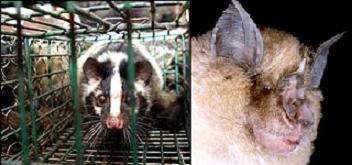A new proposal for the possible source of the respiratory disease - SARS is the horseshoe bat
Hayadan

https://www.hayadan.org.il/sars041005.html
Studies have discovered a virus similar to the SARS virus in bats from three regions of China. It is possible that before human infection there must have been infection in another creature and it will be necessary to keep the aforementioned bats away from the markets until the way of SARS transmission is understood.
The Chinese scientist Shangali Xi from the Chinese Academy of Sciences and the Department of Zoology at Beijing University announced that the similarity between the virus discovered in bats and the one that attacks humans is 92%.
The SARS disease (Severe Acute Respiratory Syndrome) broke out in 2002/3 and caused the death of 770 people and damages of billions of dollars. Its center was in East Asia with outbreaks in China and even Canada. Schools and businesses were closed and international trade was shut down, and for a time it was possible to think that the next global human disease was breaking out.
At first it seemed that the disease was breaking out from live wildlife stores in butcher shops and markets in southern China. The World Health Organization supported this connection in early 2004, and ordered the Chinese authorities to begin the destruction of about 10,000 animals, mainly civets (an animal from which certain types of perfumes are produced), and also other animals suspected of transmitting SARS.
But after the test, doubts began about the role of the civet in the transmission of the disease. One of the reasons was that their vaccine for the disease was tiny, and not suitable for creatures that have been infected with the disease for a long time. Others blamed the birds. But this month, scientists at the University of Hong Kong discovered the connection between SARS and bats by discovering a virus that is 92% similar to the SARS virus in humans. A collaboration between Chinese, Australian and American scientists went even further when they discovered the virus in three species of bats.
"We don't know why exactly in these bats, and that's the number we want to investigate," Shangli-Shei told the BBC.
So the big question remains: - How does the virus jump from bats to humans? Is he being transformed into an intermediate creature such as the civet, so that he is now able to exterminate humans?
"At the moment we don't know," says Peter Dazek, director of the Consortium for Drug Conservation in New York who was also involved in the research, "but we compare to other viruses such as Ebola where it seems as if the virus appears in chimpanzees before infecting humans. Also, the Nipah virus that appeared in Malaysia in 1998/99 also appears in bats but must pass through pigs before it attacks humans."
Hence the civet could be the surrogate-amplifier for Sars and Peter Dazak's proposal to keep it away from the bats. But it will not be an easy task to keep away these creatures that are used for food and medicine in these areas.
But this is not a closed matter and we must understand this disease better, and this is also the intention of the Chinese research group. This will be done by changing one of the amino acids in the virus while monitoring if the change will cause the virus to infect humans.
"These bats are common in Asia and even Europe and it is necessary to know the explosiveness of the SARS-like virus in bats" says Dr. Peter Zadak.
We must also understand and investigate human customs, which are probably the cause of this disease and even other new diseases and the change that happened to a virus that was harmless to humans for thousands and maybe millions of years, and suddenly became aggressive.
For the full news at the BBC
Ydan Hassars
Translated and processed by: Sabdarmish Yehuda
https://www.hayadan.org.il/BuildaGate4/general2/data_card.php?Cat=~~~283716401~~~124&SiteName=hayadan
